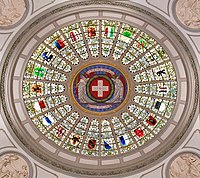Stans: Difference between revisions
→Demographics: remove extra in Stans. |
→History: expanded and added reference |
||
| Line 29: | Line 29: | ||
==History== |
==History== |
||
Stans was first mentioned in 1124.<ref name="Flueler"> {{cite book| last = Flüeler| title = Kulturführer Schweiz| publisher = Ex Libris Verlag AG| year = 1982| location = Zurich, CH| pages = 365-367}} {{de_icon}} </ref>. Following the Swiss victories in the [[Burgundian Wars]] the [[Old Swiss Confederation]] was nearly torn apart by internal conflict when the city cantons insisted on having the lion's share of the proceeds since they had supplied the most troops. The country cantons resented this and the ''[[Tagsatzung]]'' or leadership of each of the cantons met in Stans in 1481 to resolve the issues. However, they were unable to resolve the issues and war seemed inevitable. A local hermit, [[Niklaus von der Flüe]], was consulted on the situation. He requested that a message be passed on to the members of the ''Tagsatzung'' on his behalf. The details of the message have remained unknown to this day, however it did calm the tempers and led to the drawing up of the ''[[Stanser Verkommnis]]''. As part of the ''Verkommnis'' [[Fribourg]] and [[Solothurn]] were admitted into the confederation. |
|||
| ⚫ | |||
| ⚫ | In 1798 it was stormed by French troops, following the decision of Nidwalden not to adopt the constitution of the [[Helvetic Republic]]. Children orphaned by this event were gathered by the educator [[Johann Heinrich Pestalozzi]] for his first school. The open-air assembly (''[[Landsgemeinde]]'') was held in Stans annually until its abolition in 1997. |
||
==Geography== |
==Geography== |
||
Revision as of 23:24, 21 May 2009
Stans | |
|---|---|
 | |
| Country | Switzerland |
| Canton | Nidwalden |
| District | n.a. |
| Area | |
| • Total | 11.08 km2 (4.28 sq mi) |
| Elevation | 452 m (1,483 ft) |
| Population (31 December 2018)[2] | |
| • Total | 8,393 |
| • Density | 760/km2 (2,000/sq mi) |
| Time zone | UTC+01:00 (Central European Time) |
| • Summer (DST) | UTC+02:00 (Central European Summer Time) |
| Postal code(s) | 6370 |
| SFOS number | 1509 |
| ISO 3166 code | CH-NW |
| Surrounded by | Buochs, Dallenwil, Ennetbürgen, Ennetmoos, Oberdorf, Stansstad |
| Website | www SFSO statistics |
Stans is the capital of the canton of Nidwalden (Nidwald) in Switzerland.
History
Stans was first mentioned in 1124.[3]. Following the Swiss victories in the Burgundian Wars the Old Swiss Confederation was nearly torn apart by internal conflict when the city cantons insisted on having the lion's share of the proceeds since they had supplied the most troops. The country cantons resented this and the Tagsatzung or leadership of each of the cantons met in Stans in 1481 to resolve the issues. However, they were unable to resolve the issues and war seemed inevitable. A local hermit, Niklaus von der Flüe, was consulted on the situation. He requested that a message be passed on to the members of the Tagsatzung on his behalf. The details of the message have remained unknown to this day, however it did calm the tempers and led to the drawing up of the Stanser Verkommnis. As part of the Verkommnis Fribourg and Solothurn were admitted into the confederation.
In 1798 it was stormed by French troops, following the decision of Nidwalden not to adopt the constitution of the Helvetic Republic. Children orphaned by this event were gathered by the educator Johann Heinrich Pestalozzi for his first school. The open-air assembly (Landsgemeinde) was held in Stans annually until its abolition in 1997.
Geography
The area of Stans is Template:Km2 to mi2. Much of the land within the borders of Stans is agricultural (43.7%), while just over a third (36.5%) is forested. Of the remaining area, about 17% is settlements and less than 2.6% is unproductive (mountains, rivers or glaciers).[4]
Demographics
Stans has a population (as of 2007[update]) of 7579, 8.8% of which is of foreign nationality. Over the last 10 years the population has grown at a rate of 13.2%. Most of the population as of 2000[update]) speaks German (91.6%), with Italian being second most common (2.0%) and Serbo-Croation being third (1.2%). In the 2007 election the FDP party had a clear majority in Stans, receiving 88% of the vote.[4]
Industry
The town has a low unemployment rate (1.27% in 2007). There are (as of 2005) about 630 local businesses which employ about 7100 people. 1.2% of these are in the agricultural sector, 34% in trade and industry, 65% in services.[4]
Sights

The main sights of Stans are: the Stanserhorn (Template:M to ft) mountain and tourist resort, accessible via one of the oldest mountain railways in Switzerland, the Stanserhornbahn (1893), and by cable car; the main square (Dorfplatz); the parish church, St. Peter und Paul (built 1641 - 1647) with a Romanesque tower; the monastery St. Klara; a monument for the local hero Arnold von Winkelried and his birth place (Winkelriedhaus); a Capucin monastery; a salt storage house and an old alleyway (Schmiedgasse).
References
- ^ a b "Arealstatistik Standard - Gemeinden nach 4 Hauptbereichen". Federal Statistical Office. Retrieved 13 January 2019.
- ^ https://www.pxweb.bfs.admin.ch/pxweb/fr/px-x-0102020000_201/-/px-x-0102020000_201.px. Retrieved 2 June 2020.
{{cite web}}: Missing or empty|title=(help) - ^ Flüeler (1982). Kulturführer Schweiz. Zurich, CH: Ex Libris Verlag AG. pp. 365–367. Template:De icon
- ^ a b c Swiss Federal Statistical Office accessed 18 May 2009



